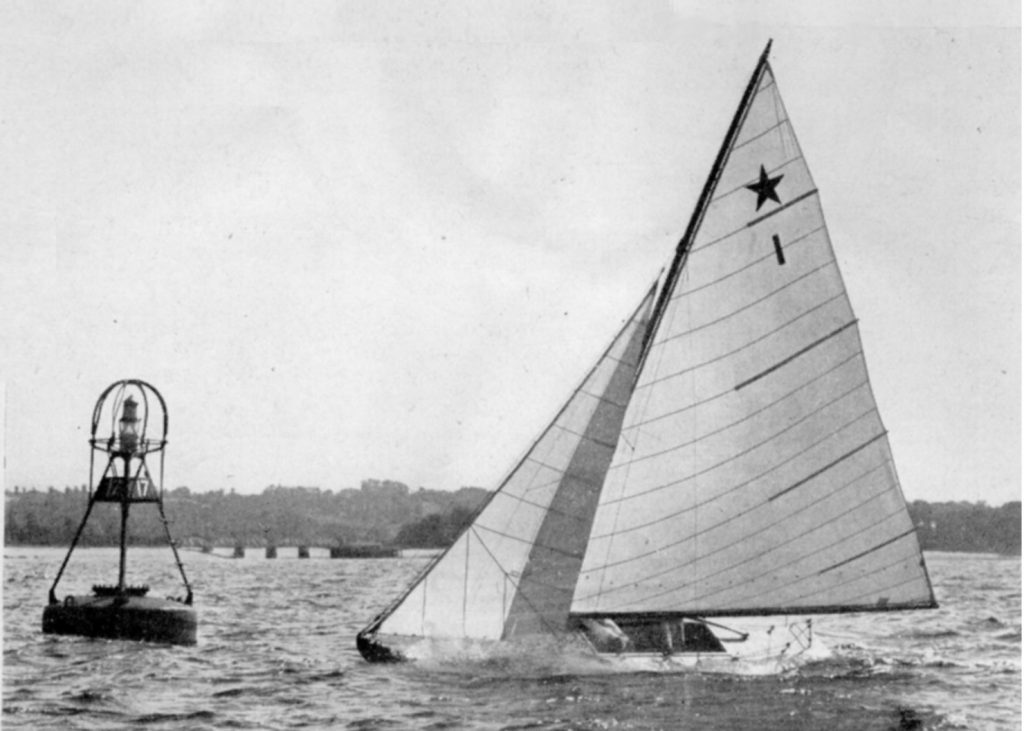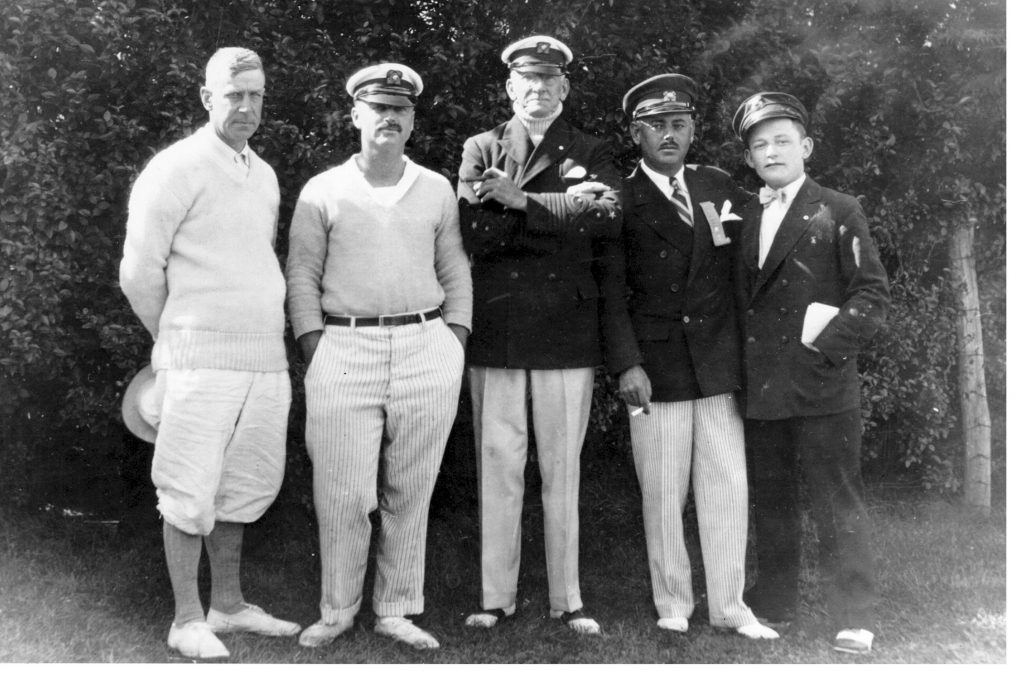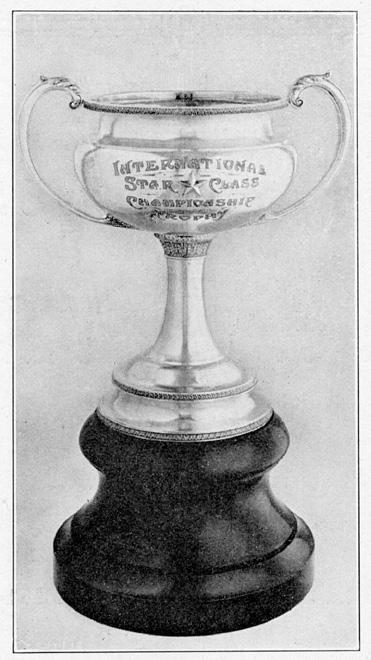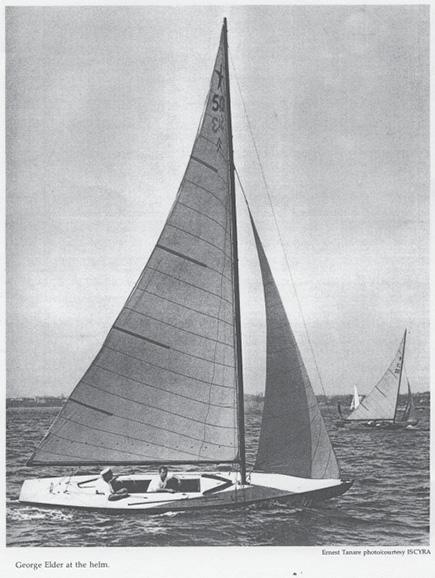1922–1932: Star Racing Expands Around the World
By Carol Newman Cronin
Published by the International Star Class Yacht Racing Association, all rights reserved

Star #1, Taurus Courtesy ISCYRA
The first decade of international Star Class competition saw exponential growth on almost every continent. In 1922, six boats sailed a championship out of Manhasset Bay in Western Long Island Sound; it was the first time that any sailors from the East and West Coasts and Great Lakes had all started together on one line. A decade later, twenty-eight boats from eight countries—each representing a different fleet—would compete out of Pequot Yacht Club, on the Connecticut side of Long Island Sound. In the years between, the championship made its first appearances on the Pacific and Gulf Coasts, as each winner brought the trophy back to their home club for the next regatta.
The first Star LOG was published in 1922 and included all of the class rules (a mere six pages). By 1923 there were 174 Stars competing in twenty fleets, five of which were beyond U.S. borders.
The second annual championship was deemed the “Internationals,” and the trophy was a large half model of a Star under full sail. Western Long Island Sound’s William. L. Inslee won on Taurus for the second year in a row, though with a different crew.

Star sailors of a century ago likely did more shivering than their counterparts of today (and possibly burned more sails with cigars and cigarettes), but they sure as hell knew how to dress for yachting. Courtesy ISCYRA
The three-race series took place in August 1923, again at Manhasset Bay’s Port Washington Yacht Club. The regatta report describes a colorful gathering of boats at anchor in front of the club, starting with the two flying British Commonwealth ensigns: “Astrea is a light blue yacht, displaying the maple leaf of Canada at her stem and the burgee of the Royal Vancouver Yacht Club at her masthead. Near her is Kangaroo, a bright red yacht, also displaying the crimson ensign but one adorned with the many pointed stars of the Southern Cross of Australia: she is the first yacht to represent New South Wales in a race in the U.S.A.”
There were also three white boats, all American: California, Doris of Lake Erie, and Ursus Minor of Eastern Long Island. Ara of Narragansett Bay was blue, and Peacock, of Central Long Island, had a “hull of shining mahogany not disfigured by any paint.” William. L. Inslee and crew posted a 1-2-1 on the black-hulled Taurus, the first Star ever built; she wasn’t mentioned as part of the anchored fleet because Inslee joined the group at the starting line.
Fifty-six new boats were built in 1923, the largest number in any one design class. The winter of 1923–24 marked a significant reorganization of class structure to better manage its growth. Beginning with the January 1925 issue, membership included a monthly mailing of Starlights and an annual Star LOG, which had previously been sent only to subscribers. Dues were set at $5.00 for boat owners and $2.50 for associates (non-owners).

The first International Star Class championship trophy Courtesy ISCYRA
Secretary-in-Chief George Elder’s goal was to streamline communications, replacing “hundreds of unnecessary letters” with standardized printed forms, supplemented by instructions on the last page of each Starlights. We get a sense of the frustrations brought on by rapid class growth from this reminder about the new system: “…there will be no…personal letter coaxing neglectful officers to do their work, or urging careless members to record their boats and pay dues. No one has time to do the other fellow’s work. The man who cannot do his bit toward providing his own pleasure, which is all this Association is for, will have to suffer accordingly.” Elder also expressed hope that a monthly newsletter would help preserve “fraternal feeling,” even as the class expanded to include a wide variety of cultures and nationalities.
By the start of 1924, there were 216 members in good standing. Stars now raced or were built on every inhabited continent except South America, out of forty-two different yacht clubs. And, according to Elder in the first class History, published in 1931, it had become “practically impossible to record the names of those responsible for the development of fleets as they multiply, consolidate, and subdivide…the public was beginning to realize that the Star Class offered International yacht racing in a form that it could both understand and even afford to participate in. Old traditions had been swept aside and the Star Class had won its battle for recognition.”
The first Gold Star was awarded in 1924 for the first Internationals to attract ten boats; it was also the first five-race series. At the 1924 membership meeting (held during the regatta), “the old International Trophy was retired and presented to the Bayside Yacht Club [in Queens, New York] in recognition of having been won three times by a member of that club. A new and more representative one was obtained, our present cup, by popular subscription from the membership.”
The entry list in 1925 boasted fifteen boats, but regatta winners continued to hail from the Western Long Island Sound fleet—until 1928, when Narragansett Bay’s Walton Hubbard Jr. and Richard Edwards “finally wrenched the trophy away.” A four-year tour of the country eventually touched every coastline except the Great Lakes. In 1931 the trophy returned to Long Island Sound, though in 1932 it would again be taken back to Long Beach, California, by “Two Round Eddie” Fink.

George Elder, the father of the Star Class Association, at the helm Ernest Tanare photo/Courtesy ISCYRA
Measurement certificates were first issued in 1927. In 1930, the modern Marconi rig dimensions were adopted, sparking European expansion despite a worldwide economic depression.
The first mention of a female Star sailor is in the 1932 regatta report. “Patsey Raskob, an eleven year old school girl, handled her Ripple like a veteran and would have finished among the leaders had she not disqualified herself in the first race. To C. Lowndes Johnson, the ‘Little Buzzard’ [and 1929 Gold Star winner] goes the credit of having developed this child marvel, and it is also to his credit that he is instilling into his pupils a true spirit of sportsmanship as well as skill.”
And in a fitting close to this incredible first decade of international competition, the Star made its Olympic debut at the 1932 Games in Los Angeles. Though most of the period’s jokes haven’t aged well, a reference to “near-beer” reminds us why the Star Midwinter Championship in Havana was such a perfect winter escape; there was no Prohibition in Cuba. ■
Special thanks to Jerelyn Biehl at the International Star Class Yacht Racing Association for assistance with this story. A beautifully produced book, 100 Years of Gold Stars is available from the ISCYRA website at starclass.org/history/history.
Carol Newman Cronin is a lifelong sailor who’s won several national and international championships. As a member of the U.S. Olympic Team, she and teammates Liz Filter and Nancy Haberland won two races in the Yngling class at the Athens Olympics in 2004. She competes internationally in a variety of classes and lives in Jamestown, RI. You’ll find more information (including book signing dates) at Carol’s blog, Where Books Meet Boats, at carolnewmancronin.com.
